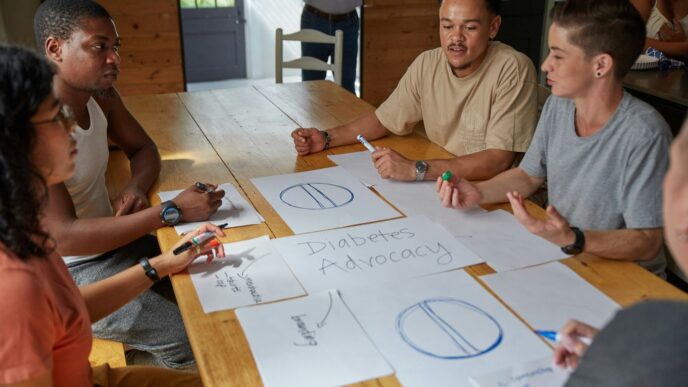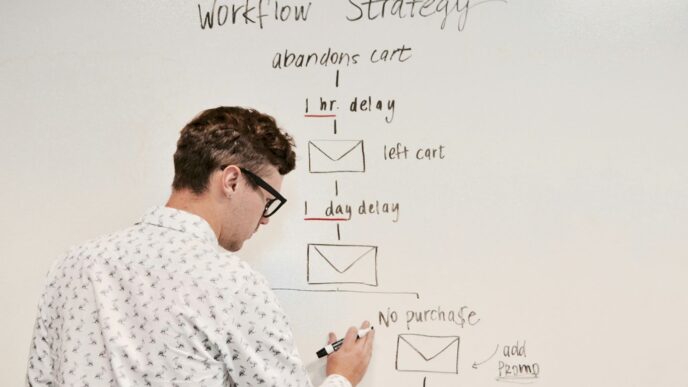In today’s crowded market, brands need to get creative to grab attention. Traditional ads can sometimes feel a bit… much. That’s where branded content comes in. It’s all about telling a story or providing value in a way that feels natural and engaging, rather than just trying to sell you something. Think of it as a brand showing you what it’s all about without being pushy. We’ve looked at a bunch of companies that really nailed this. Here are some top branded content examples that show off some serious marketing smarts.
Key Takeaways
- Coca-Cola’s use of seasonal themes, like their iconic polar bears during holidays, makes their brand feel timely and connects with people’s traditions and feelings.
- Dollar Shave Club’s early viral video and ongoing funny, relatable content showed how to stand out in a busy market by being yourself and speaking directly to your audience.
- Nike often shares stories of athletes achieving their goals, which inspires people and makes the brand feel connected to dreams and hard work.
- Red Bull’s massive investment in the Stratos jump wasn’t just a stunt; it was a bold branded content example that showed the brand’s adventurous spirit and pushed boundaries.
- Spotify’s personalized playlists are a brilliant branded content example because they use user data to create something unique and valuable for each person, making the service feel personal.
Coca-Cola: Take Advantage Of Seasonality
You know how some brands just own a certain time of year? Coca-Cola has totally nailed that with the holiday season. Think about it – those iconic polar bear commercials? They’ve become as much a part of Christmas as twinkling lights and carols for a lot of people. It’s not just about selling soda; it’s about tapping into those warm, fuzzy feelings of family, joy, and togetherness that come with the holidays. They’ve made their brand synonymous with festive cheer.
It’s a smart move because it connects the product to positive memories. When you see those happy, animated polar bears, it just feels good. And the fact that they often run these ads without much dialogue, relying on music and visuals, makes them universally appealing. It’s a pattern interrupt that sticks with you. Plus, by consistently using the polar bear character, they’ve created a brand icon that’s instantly recognizable and can even be used on merchandise, opening up more sales avenues. It’s a classic example of how tying your brand to a specific, emotionally charged season can create lasting connections with consumers.
Dollar Shave Club: Never Be Lost In A Sea Of Competition

It’s tough out there for a new brand, right? You’ve got all these big names, and it feels like you’re just a tiny fish in a giant ocean. So, how do you get noticed? Dollar Shave Club figured this out early on. They didn’t try to be fancy or complicated. Instead, they made a video that was just plain funny and got straight to the point.
Their whole idea was simple: good razors, delivered to your door, for a dollar a month. That’s it. But the way they said it in their first viral video? That’s what made them stand out. It wasn’t your typical slick ad. It was a bit rough around the edges, featured a guy walking through a warehouse with weird stuff happening, and it was hilarious. This kind of humor and directness really connected with people who were tired of paying a fortune for razors.
What can we learn from this?
- Know who you’re talking to: Dollar Shave Club knew their audience wasn’t looking for a super-premium, complicated shaving experience. They wanted something easy and affordable.
- Don’t be afraid to be different: While other companies were showing perfect, smooth faces, DSC showed a more relatable, everyday guy.
- Humor works: Making people laugh is a great way to get them to pay attention and remember you. Their video got millions of views because it was shareable and entertaining.
They didn’t just stop at that one video, either. They kept making content that their audience would enjoy, like their "Bathroom Minutes" newsletter. It shows that once you grab attention, you need to keep giving people a reason to stick around. It’s a great example of how to build a brand by being authentic and understanding your customers, which is a key part of disrupting the market.
Nike: Helping Make Dreams A Reality
You know Nike. They make athletic gear, sure, but they’re also masters at making you feel something. Their marketing often goes beyond just showing off shoes or shirts. Instead, they tell stories. Think about their ads that feature athletes, not just the famous ones, but everyday people too, pushing their limits. They show the struggle, the sweat, and then, the triumph. It’s about more than just winning a race; it’s about the journey and what it takes to get there.
Nike really knows how to connect with people on an emotional level, making their brand feel like a partner in achieving personal goals. They tap into that universal desire to be better, to overcome obstacles, and to reach for something more. It’s not just about selling a product; it’s about selling an idea, a feeling of possibility. They use music and visuals in a way that really pulls you in, making you feel inspired even if you’re just sitting on your couch.
What can we learn from this? Well, for starters:
- Focus on the narrative: People remember stories much more than they remember product specs. What’s the story behind your brand or your customer’s success?
- Inspire, don’t just sell: Show how your product or service helps people achieve something meaningful. What dream does it help make a reality?
- Use emotion: Music, visuals, and relatable characters can create a powerful connection that facts and figures alone can’t achieve.
Busch Light: Sponsorships And Influencers
Busch Light really knows how to connect with its audience, and a big part of that is how they use sponsorships and influencers. They found this guy, ‘You Betcha,’ who’s got a huge following, especially in the Midwest. Think of folks who appreciate simple things, maybe work with their hands, and enjoy a cold beer after a long day. That’s exactly who Busch Light is trying to reach.
By partnering with someone like ‘You Betcha,’ Busch Light taps into an existing community and builds trust through a personality people already look up to. It’s not just about him holding a can; his whole vibe and the content he creates naturally fit with the Busch Light brand. His followers see him enjoying it, and because they trust his judgment, it makes them think, ‘Hey, maybe I should try that too.’ It feels pretty authentic because it’s not some slick, overproduced ad. It’s more like seeing a friend recommend something they genuinely like.
This approach works because it feels real. When you see content that isn’t trying too hard, it’s easier to believe. It’s like when a friend tells you about a great new pizza place – you’re more likely to check it out than if a giant billboard told you to go. Busch Light understands that.
Here’s a bit of what makes this strategy effective:
- Targeted Audience Connection: They identified a specific group of people who are the ideal customers for Busch Light and found a way to speak directly to them through a relatable personality.
- Authenticity Over Polish: The content doesn’t need fancy editing or a huge budget. Simple, genuine moments often connect better than something that looks too manufactured.
- Building Trust: When an influencer or sponsored personality genuinely uses and enjoys a product, their audience’s trust in that product grows. It’s a recommendation from someone they feel they know.
- Humor and Shareability: The content often uses humor that resonates with the audience, making it something people want to share with their own friends. This naturally spreads the brand’s message without feeling like a hard sell.
Slack: Product Led Growth

Slack really nailed it with their approach to growth, and it’s all about letting the product speak for itself. Instead of trying to convince big bosses who might not get it right away, they focused on the people actually doing the work – the software users. Makes sense, right? These are the folks who feel the daily pain points that Slack is designed to fix.
Their marketing often highlights how much faster and easier communication becomes. It’s not about listing a bunch of fancy features; it’s about showing the outcome: a more connected and productive team. Think of it like this:
- Faster communication: Get messages and updates instantly.
- Better teamwork: Keep everyone on the same page, no matter where they are.
- Less clutter: Cut down on endless email chains.
The whole vibe of their ads is bright and quick, mirroring that feeling of efficiency. They use simple, eye-catching animations that just feel friendly and approachable. It’s like they’re saying, “Hey, your workday can be less of a headache.” This focus on the user’s direct experience is what makes their product-led growth strategy so effective. It’s a smart way to get people hooked by showing them exactly how their lives can improve, one message at a time.
Old Spice: Data Is Vital For Ads To Convert
You know, sometimes you see an ad and just think, ‘Wow, they really get it.’ Old Spice managed to do that a few years back with their ‘The Man Your Man Could Smell Like’ campaign. It was funny, memorable, and honestly, pretty brilliant. But the real genius wasn’t just the humor; it was how they used data to figure out who to talk to.
See, they realized that while men were the ones using the body wash, women were actually buying it. Like, a lot of it. Studies showed women were making about 60% of those purchases. So, instead of just talking to the guys, they smartly shifted their focus to the ladies. This insight, that the buyer isn’t always the user, is gold for any marketer. It’s a great reminder to dig into your sales figures and understand the actual decision-makers.
They also picked a relatable celebrity, Isaiah Mustafa, a former NFL player. This wasn’t random. Launching during the Super Bowl meant tapping into an audience that already appreciated that kind of athletic, masculine vibe. It’s about finding those connections that make your audience nod and say, ‘Yeah, I see that.’
Here’s a quick breakdown of what made it work:
- Targeting the Real Buyer: Focusing on women, who were the primary purchasers.
- Relatable Spokesperson: Using a celebrity who appealed to the target demographic.
- Memorable Messaging: Creating a unique and humorous tone that stuck with people.
And the reach? It went way beyond just TV. That ad racked up millions of views online, proving you don’t always need a massive TV budget to get big results. It’s a solid example of how understanding your audience through data can really make your advertising efforts pay off, just like they did for Old Spice’s brand repositioning.
Twix: Compete Against Your Product
You know how most brands try to make their product look amazing by inventing some fake rival? Well, Twix did something totally different and, honestly, way more clever. Instead of creating a made-up competitor, they basically pitted their own Left Twix against their Right Twix. Mars Inc. came up with this whole backstory about two separate factories, right across the street from each other, making these two versions of the same candy bar. It’s a silly, dramatic feud, and it’s brilliant because, no matter which one you pick, Twix wins.
This whole "Left vs. Right" thing really got people talking. It’s funny, right? You have people firmly on Team Left Twix or Team Right Twix, and they’ll argue about it. It’s a great way to get your audience invested and create a buzz that lasts. They didn’t just sell a candy bar; they sold a whole debate.
Here’s what makes this marketing move so smart:
- Creates a unique conversation starter: People still ask each other, "Are you Left or Right Twix?" It’s a simple question that keeps the brand top of mind.
- Engages the audience in a fun way: The whole rivalry is humorous and over-the-top, making it relatable and entertaining. It taps into that feeling of having a favorite, even if it’s just a candy bar.
- Ensures brand loyalty regardless of choice: Whether you grab a Left or a Right, you’re still buying a Twix. It’s a win-win for the company, making sure they benefit no matter what the consumer decides.
Red Bull Stratos: Big Results Require Big Investment
You know, sometimes you see a marketing stunt so big, so audacious, it makes you stop and think, ‘Wow, they really went for it.’ That’s exactly what the Red Bull Stratos project was. It wasn’t just an ad; it was a five-year mission that culminated in Felix Baumgartner’s record-breaking freefall from the edge of space. This event perfectly embodied Red Bull’s slogan, ‘Red Bull gives you wings,’ by literally sending someone higher than any bird could ever fly.
Think about the sheer scale of it. We’re talking about years of planning, training, and technological development. It wasn’t a cheap endeavor by any stretch of the imagination. Red Bull poured significant resources into making this happen, and the payoff was immense. They didn’t just create a moment; they created a global spectacle that people talked about for ages. It’s a fantastic example of Red Bull’s marketing strategy in action, showing how a bold investment can yield massive returns.
What can we learn from this? Well, for starters, big ideas often need big budgets. You can’t expect to create a world-stopping event on a shoestring. It requires:
- Dedicated Planning: Five years of work went into this. That’s not something you rush.
- Technological Investment: They needed cutting-edge gear and expertise.
- Global Reach: The event was broadcast live, reaching millions.
This wasn’t just about selling a drink; it was about associating the brand with pushing boundaries and achieving the impossible. It generated incredible buzz, social media engagement, and cemented the brand’s image as one that supports extreme feats. It’s a powerful reminder that sometimes, to get truly remarkable results, you have to be willing to make a truly remarkable investment.
DoorDash: Be Sensitive To Your Audience’s Feelings
Remember back in 2020 when everything felt so uncertain? Businesses were struggling, and people were worried. DoorDash really stepped up during that time with a campaign that showed they understood what was going on. They didn’t just try to sell food; they showed support for local restaurants when they needed it most.
It was a smart move because so many places were hurting. DoorDash highlighted how these restaurants were still open for delivery, even if their dining rooms were empty. They used real chefs and operators, which made the message feel genuine. It was like they were saying, "We’re here for them, and you can be too." That kind of message really hit home when people were looking for ways to help out.
Here’s what made it work:
- Timing was everything: Launching this during the pandemic showed they were paying attention to the world around them.
- Supporting local: They focused on helping small businesses, which is something many people care about.
- Emotional connection: The ads reminded people of the good times in restaurants and encouraged them to keep supporting them through delivery.
DoorDash didn’t just run a few ads online; they went big with TV spots and social media. It was a multi-channel approach that reached a lot of people. By being sensitive to the tough situation everyone was in, DoorDash managed to build goodwill and show they were a brand that cared.
Southwest Airlines: Stories Of Real People
You know, sometimes the best marketing isn’t about flashy graphics or catchy slogans. It’s about people. Southwest Airlines really gets this. They’ve built a whole campaign around the idea that there’s a personal reason behind every flight booked. It’s not just about getting from point A to point B; it’s about the human stories that make those journeys happen.
They dug into their customer base and found actual stories. Think about it: a coach heading to a big game, a grandmother finally taking that dream trip, parents on the verge of adopting, or an artist rushing to a performance. These aren’t just abstract travelers; they’re real individuals with goals and emotions. Southwest took these narratives and put them front and center. This approach makes the airline feel much more relatable and human. It’s a smart way to connect with people on a deeper level, reminding everyone that they’re more than just a ticket number.
It’s a powerful reminder that behind every seat on their planes, there’s a unique story unfolding. This kind of authentic storytelling really sticks with you, doesn’t it? It’s a great example of how focusing on the customer’s experience can be incredibly effective. You can see more examples of their employee-driven stories on their "That’s So Southwest" page. It’s a nice touch that shows they’re paying attention to the real lives of their passengers.
GEICO: Use Catchy Jingles
You know, sometimes the simplest things stick with you the longest. For GEICO, it’s definitely their jingles. They’ve managed to make insurance advertising, which let’s be honest, isn’t exactly thrilling, into something people actually remember, and even look forward to. Think about the ‘Hump Day’ camel. That little guy and his Wednesday obsession became a whole cultural moment. It wasn’t just a commercial; it was a meme before memes were really a thing.
What’s so smart about it? Well, for starters, it’s incredibly memorable. A catchy tune or a funny character can lodge itself in your brain way more effectively than a dry recitation of policy benefits. GEICO figured this out ages ago. They’ve consistently used animals and simple, repeatable phrases to build brand recognition. It’s like they’ve created a whole cast of characters that people feel a connection with, even if it’s just a gecko or a camel.
Here’s a breakdown of why their jingle strategy works so well:
- Simplicity is Key: The messages are never complicated. You hear the jingle, you see the character, and you know it’s GEICO. They don’t try to cram too much information into a short ad.
- Humor Connects: Let’s face it, insurance can be a bit of a drag. GEICO injects humor, making the ads enjoyable. Who doesn’t like a good laugh? It makes the brand feel more approachable.
- Repetition Builds Recognition: They stick with what works. The same characters and similar musical styles appear across different campaigns, reinforcing the brand identity over time. It’s like hearing your favorite song on the radio – you know who it is right away.
Their ability to create earworms that stick in your head is a masterclass in making the mundane memorable. It’s a reminder that even in a crowded market, a little bit of creativity and a lot of repetition can go a long way in making your brand stand out.
Spotify: Make It Personal
You know how sometimes you just want to know what you’ve been listening to all year? Spotify totally gets that. Their ‘Wrapped’ campaign is a masterclass in making data feel like a personal party.
It’s not just about showing you your top songs, though. Spotify takes your listening habits and turns them into these super shareable, visually fun summaries. This makes users feel seen and understood, turning a simple app into a reflection of their own tastes. Think about it: you get to see your most played artists, how many minutes you spent jamming, and even discover new music based on what you already love. It’s like a personalized mixtape curated just for you, every single year.
And it’s not just for listeners. They also do a ‘Wrapped’ for artists and podcasters, letting them see their own stats and thank their fans. This creates a whole ecosystem of sharing and engagement. It’s pretty smart because it encourages everyone involved – the listeners, the creators, and Spotify itself – to get involved and spread the word.
Here’s a quick look at why it works so well:
- Personalization: It takes your unique listening data and makes it something special.
- Shareability: The format is designed to be easily shared on social media, acting as free advertising.
- Community Building: It connects fans with artists and podcasters, creating a sense of shared experience.
- Data Visualization: Complex data about listening habits is presented in an easy-to-understand and engaging way.
Honestly, it’s a brilliant move. They’re not just selling music streaming; they’re selling a personalized experience that people genuinely look forward to and talk about. It’s a great example of how understanding your audience and giving them something unique can really pay off.
Old Navy: Let Your Audience Inspire You
You know, sometimes the best ideas don’t come from inside the company at all. Old Navy totally nailed this with their "Written by the Internet" campaign. Instead of just guessing what people wanted, they actually asked their social media followers for input on what they’d like to see in an ad. It was pretty smart because it got a ton of people talking – over 1,500 comments, which is a lot! This basically turned their online fans into co-creators for the brand.
It’s a great way to make customers feel more connected. When a brand actually listens and uses your ideas, you feel like you’re a part of something. Old Navy even ended up hiring the TikToker whose suggestion really stood out. This kind of collaboration really helps build a stronger bond, especially with a younger audience who appreciates being heard. It shows they’re not just trying to sell you clothes; they’re building a community. You can see how this approach can lead to some really engaging apparel product page examples down the line, too.
What can we learn from this?
- Listen to your customers: It sounds simple, but really paying attention to what your audience is saying on social media or through email can give you gold.
- Involve them in the process: Letting people contribute to ads or campaigns makes them feel invested.
- Be responsive: Showing that you’re willing to act on feedback makes your brand seem more human and relatable.
This whole thing just goes to show that sometimes, the most brilliant marketing comes from simply asking the people who love your brand what they want to see. It’s a win-win: they get to influence something they care about, and the brand gets authentic content and a more loyal following.
Sephora: Foster A Sense Of Belonging
You know, sometimes it feels like the beauty world can be a bit… exclusive. Like there’s a secret handshake or a specific look you need to pull off. But then you see brands like Sephora doing things that really make you feel seen. They’ve got this whole vibe going on about inclusivity, and it’s not just lip service. It’s like they’re saying, ‘Hey, whoever you are, whatever you look like, you belong here.’
Think about their campaigns that highlight different people, different stories. It’s not just about selling makeup; it’s about showing that beauty comes in all forms. This approach helps build a community, not just a customer base. When people feel like they’re part of something, they stick around. It’s pretty smart, actually. They’re not afraid to speak up about things that matter, like supporting the transgender and non-binary community. That kind of stance, when it’s genuine, really connects with people on a deeper level. It shows they have values, and they’re not just trying to sell you something.
Here’s what makes their strategy work:
- Authenticity: They align their marketing with their actual company values. If diversity and inclusion are important to Sephora, their ads reflect that. It’s not just a slogan; it’s in their actions.
- Taking a Stand: In an industry that sometimes stays quiet on social issues, Sephora isn’t afraid to voice its support for important causes. This humanizes the brand and builds trust with an audience that shares those values.
- Community Building: By making people feel welcome and represented, Sephora creates a loyal following. It’s about more than just transactions; it’s about belonging.
Starbucks: User-Generated Content
Starbucks really hit the nail on the head with their "Meet Me at Starbucks" campaign. It’s a fantastic example of how to use content created by everyday people to build a brand story.
Think about it: in a world that feels more disconnected than ever, Starbucks used this campaign to remind us about the simple joy of meeting up with someone in person. It wasn’t about fancy actors or staged scenarios; it was about real people, from all over the globe, using Starbucks as that common ground for connection. They showed folks from 28 different countries, which is pretty neat because it makes the whole thing feel personal, no matter where you are or who you are. It’s a good reminder that people connect with stories they can see themselves in.
What can we learn from this? Well, for starters, creating relatable stories is key. Starbucks knew people use their shops for all sorts of things – first dates, catching up with friends, even casual business meetings. By showing these everyday moments, they tapped into something authentic. Plus, they made sure to represent a wide range of people and places, showing that they care about everyone who walks through their doors. It’s a smart way to make your brand feel inclusive and relevant to a huge, diverse audience.
Patagonia: Purpose-Driven Marketing
Patagonia really stands out because they don’t just sell outdoor gear; they sell a whole lifestyle and a set of values. Their marketing isn’t about pushing products, it’s about pushing a mission. They’ve built a brand that people connect with on a deeper level because it aligns with their own beliefs about the environment.
Think about their "Worn Wear" initiative. Instead of always encouraging you to buy new stuff, they promote repairing and reusing their clothing. They even have a whole section on their website dedicated to fixing your gear. This is pretty radical when you consider most companies want you to buy, buy, buy. Patagonia is saying, "Hey, our stuff is built to last, and we want it to last." It’s a smart way to build loyalty because it shows they care about more than just profit. They’re showing they care about the planet and about their customers getting the most out of their purchases.
It’s not just about fixing things, either. Patagonia consistently puts its money and voice behind environmental causes. They’ve run campaigns highlighting issues like protecting public lands or fighting climate change. They use their platform to educate and mobilize people, which is a huge part of their brand identity. This kind of commitment makes people feel good about supporting them. It’s like, you’re not just buying a jacket; you’re supporting a company that’s actively trying to make a difference. This approach has really helped them connect with a specific audience that values sustainability and activism, making them a leader in purpose-driven marketing.
Duolingo: Witty TikTok Campaigns
Duolingo has really figured out how to make language learning feel less like a chore and more like a laugh, especially on TikTok. They’ve built a whole persona around their green owl, and honestly, it’s pretty brilliant. Instead of just pushing lessons, they jump on trends and make funny videos that feel super relatable. It’s like your quirky friend is trying to teach you Spanish, not some stuffy corporation.
What’s cool is how they use the comments section. People leave all sorts of funny remarks, and Duolingo’s replies are just as witty. It makes you feel like you’re part of a conversation, not just a passive viewer. This kind of interaction is key to building a connection with younger audiences who are always online. They’ve shown that being a bit silly and not taking yourself too seriously can go a long way on social media.
Their approach isn’t just about being funny, though. It’s about making the brand memorable. When you see a funny Duolingo video, you’re more likely to remember it later, and maybe even try out the app. It’s a smart way to get people interested without being overly salesy. They’ve really mastered how to use humor to build brand awareness and keep people engaged, lesson after lesson.
Dove: Real Beauty Campaign
You know, sometimes marketing campaigns just hit differently. Dove’s ‘Real Beauty’ campaign is definitely one of those. It’s been around for a while, but it’s still so good because it tackles something a lot of people, especially women, worry about: how they look. Instead of just showing supermodels, Dove decided to show regular people, and it really made a splash.
One of the smartest things they did was the ‘Real Beauty Sketches’ video. They had a forensic artist, who’s trained by the FBI, sketch women based on how they described themselves. Then, he sketched them again based on what a stranger described. Guess what? The stranger’s description was always way nicer and more accurate. It basically showed everyone that we’re often our own harshest critics. That simple idea, that you’re probably prettier than you think, really stuck with people. It made you feel good about yourself, and that positive feeling got linked to the Dove brand. It wasn’t about selling soap; it was about making people feel seen and appreciated.
Here’s what made it work so well:
- It addressed a real insecurity: Many people feel pressure to look a certain way. Dove tapped into that anxiety and offered a message of self-acceptance.
- It used an expert for credibility: Bringing in a forensic artist added a layer of seriousness and proof that it wasn’t just marketing fluff.
- The message was simple and positive: The tagline, “You’re more beautiful than you think,” is easy to remember and uplifting.
It’s a great reminder that marketing doesn’t always have to be about flashy ads. Sometimes, just being real and connecting with people on an emotional level is the most effective way to build a brand. It’s about understanding what your audience is going through and offering them a bit of comfort and confidence.
Google’s Year In Search: Data-Driven Marketing
One of the most powerful examples of data-driven storytelling comes from Google’s annual "Year In Search" campaign. Every year, Google sorts through billions of global searches and pulls together the world’s top trending terms, questions, and topics. It’s more than just a collection of keywords—it’s a snapshot of what people actually cared about, worried over, or celebrated all year long.
Here’s what makes Year In Search such a standout branded content campaign:
- It’s highly relatable. Whether you searched for the latest World Cup scores or how to bake sourdough, chances are, you see some of your own story in those top trends.
- Community feeling. By rounding up shared topics—from viral dance crazes to big news moments—Google taps into a sense of global togetherness and nostalgia.
- It’s personal and vast at the same time. The campaign feels both universal and specific; everyone can spot a search that feels like it came from their own life.
If you’re curious what this might look like in a given year, here’s an example of what Google might break down in their annual campaign:
| Search Topic | Purpose or Emotion |
|---|---|
| "How to help Ukraine" | Support, empathy |
| "Wordle" | Entertainment, curiosity |
| "Gas prices near me" | Money-saving, practical worry |
| "Queen Elizabeth II" | Tribute, historical events |
Google weaves all this into a video and social campaign, topped off with a hashtag like #YearInSearch. They encourage people to share their own stories connected to these trends. The result? People recognize themselves in the data, and the brand earns trust—all by showing it has its finger on the pulse of real, everyday life.
Long story short, Google’s Year In Search does something most brands wish they could: it turns raw numbers into something people actually want to talk about. If you’ve ever wondered how to make data feel meaningful, you could do a lot worse than copying a play or two from Google’s book.
John Lewis: Anticipated Christmas Celebration
You know how some brands just own a particular time of year? John Lewis, a big department store in the UK, has totally nailed the Christmas season. They don’t just put out a few ads; they create this whole event that people actually look forward to. It’s like a yearly tradition for many, building up excitement way before the big day.
What’s really smart about their approach is how they tell a story. Take one of their campaigns, for instance. It showed a guy learning to skateboard, which seemed a bit random at first. But then, the reveal! He was doing it to connect with a child they were fostering who loved skateboarding. It’s this kind of emotional, unexpected twist that makes their ads so memorable. They don’t just shove products in your face. Instead, they weave in a single item, like that skateboard, into a narrative that tugs at your heartstrings. Plus, they often highlight charities they work with, giving a platform to good causes that might not get much attention otherwise. It’s a win-win: they get to tell a powerful story, and the charities get some much-needed visibility. It really shows that sometimes, the simplest stories, told with the right music and visuals, can have the biggest impact.
Lenovo Late Night IT
You know, sometimes the tech world can feel a bit… much. All those complicated terms and serious faces, right? It’s easy to get lost. That’s where Lenovo’s ‘Late Night IT’ series comes in. They decided to tackle those big tech topics, but with a twist. Instead of a stuffy lecture, they went for a comedy news show vibe.
Think of it like this:
- Making complex subjects relatable: They talked about things like cybersecurity and data management, but in a way that didn’t make your eyes glaze over. It felt more like chatting with friends who actually know their stuff.
- Honest conversations: The hosts and guests weren’t afraid to be real. They had these unfiltered discussions that cut through the usual corporate speak. It was refreshing to hear genuine opinions.
- Focusing on real issues: One episode even tackled mental health in the workplace, specifically for people in tech. They asked tough questions, like whether companies are actually doing anything for employee well-being or just slapping on a quick app fix. It’s a great example of how branded content can address important social topics while still being entertaining.
Lenovo’s approach here was pretty smart. They didn’t just push their products. Instead, they created content that was genuinely interesting and addressed common concerns in the tech industry. It’s a good reminder that sometimes, a bit of humor and honesty can go a long way in connecting with your audience.
LeadPages: ConversionCast Podcast
In the crowded world of landing page builders, LeadPages found a way to stand out, and a big part of that was their podcast, ‘ConversionCast.’ It wasn’t just another marketing tool; it was a smart move to connect with people who were serious about growing their online presence. They brought in Tim Paige, someone who really knew how to make a podcast shine, to get it off the ground.
The podcast focused on the latest in marketing news and strategies. Think of it as a regular check-in with experts, discussing what’s working right now and what might work tomorrow. This kind of content is gold for businesses trying to keep up in the fast-paced digital space. It’s not just about selling a product; it’s about providing real, actionable advice.
Here’s what made ‘ConversionCast’ work so well:
- Expert Interviews: Bringing on industry leaders to share their insights.
- Strategy Breakdowns: Deep dives into successful marketing tactics.
- News and Trends: Keeping listeners informed about the ever-changing digital landscape.
This approach helped LeadPages grow significantly, reaching tens of thousands of customers and bringing in millions in revenue within just a few years. It shows that even with a small team, creating high-quality, informative content like a podcast can make a huge difference, especially when you’re up against bigger players in the market.
SecureWorks: Mastery Of The Marketing Funnel
It might seem a bit surprising, but cybersecurity companies can actually be pretty good at content marketing. Take SecureWorks, for instance. They really figured out how to map out what potential customers need to know at every step of their buying journey. It wasn’t just about throwing content out there; it was about being smart with it.
They brought in a new marketing director, Kira Mondrus, who had a clear idea: focus on the audience. This meant really digging into the questions and problems people had, whether they were just starting to think about cybersecurity or were ready to buy. They broke the customer’s path down into three main parts:
- Engage: This is where people are just starting to learn about general business issues related to security.
- Nurture: Here, they’re looking for more specific information and how different solutions might help.
- Convert: At this final stage, they’re focused on what SecureWorks specifically can do for them.
This approach meant they created different kinds of content for each stage, avoiding the mistake of pushing product demos too early. They produced a mix of things like webcasts, white papers, case studies, videos, and podcasts. This way, no matter where someone was in their decision-making process, SecureWorks had something relevant for them. It’s pretty smart because it guides people along without being pushy. And guess what? This strategy really paid off, helping them boost conversions by over 50% and close deals with a lot of the new leads they generated.
GE: Instagram Campaign
General Electric, a company many might think of as strictly industrial, really shook things up with their #GEInstaWalk campaign on Instagram. They wanted to show people what goes on behind the scenes, beyond just the factory floor. It was a smart move to make a typically ‘boring’ company seem more interesting, especially to younger folks who might become future employees or investors.
They invited Instagram influencers to tour their facilities, like the Aviation Engine Testing Centre. These influencers then shared amazing photos using the hashtag #GEInstaWalk. They even let the public join in through contests. It was a pretty cool way to get people involved and see GE’s work up close.
Here’s a look at the impact:
- Millions of Views: The campaign brought in over 3.8 million unique viewers to GE’s Instagram account.
- High Engagement: Within just a few days, there were over 200,000 engagements.
- Follower Growth: GE gained 3,000 new Instagram followers, all without spending money on ads.
This whole thing shows that even a big, established company can find creative ways to connect with people on social media. It’s a great example of how a well-planned social media strategy can really boost brand visibility. You can find more great content marketing examples like this one here.
GoPro: Consumer-Generated Advertising
You know, it’s pretty wild how some companies just nail it when it comes to getting their customers to do the heavy lifting for their marketing. GoPro is a prime example of this. Instead of spending a ton of money creating their own slick videos, they basically said, ‘Hey, you guys are out there doing awesome stuff with our cameras, show us!’ And people did. They started sharing these incredible, action-packed videos they filmed themselves.
This whole approach is what you call consumer-generated advertising. It’s basically letting your customers be your brand ambassadors. For GoPro, this meant they could showcase their product in real-world, high-adrenaline situations without having to stage it all themselves. It felt authentic because, well, it was. They also smartly partnered with athletes, tapping into those existing fan bases. It was a smart two-part strategy that really paid off.
What’s really interesting is how they formalized this. They have things like the GoPro Awards, where they literally ask people to submit their best footage for a chance to win prizes. It’s a win-win: GoPro gets amazing content, and users get recognition and rewards. It’s a fantastic way to get user-generated content that feels genuine.
And the results? Pretty mind-blowing. We’re talking about a massive 75% jump in sales year over year. Their YouTube channel views shot up by 84%, and people were watching for 140% longer. Now they have millions of subscribers. It just goes to show that if you can get your audience involved, they can be your most powerful marketing tool. It’s not just about having a good product; it’s about building a community around it.
Wrapping It Up
So, we’ve looked at a bunch of cool ways brands are doing content marketing these days. It’s pretty clear that just shouting about your product isn’t going to cut it anymore. People want stories, they want to feel something, and they want brands to be real with them. Whether it’s making people laugh, tugging at their heartstrings, or just being super helpful, these examples show that connecting with your audience on a human level is the name of the game. It takes some thought and effort, sure, but building that connection is what really makes a brand stick around and get noticed. Keep these ideas in mind, and you might just find your own way to create content that actually works.
Frequently Asked Questions
What exactly is branded content?
Branded content is like a story or an experience that a company creates. It’s not a direct advertisement trying to sell you something right away. Instead, it aims to entertain or inform you in a way that makes you feel good about the brand, helping you connect with it.
Why do companies use branded content instead of regular ads?
Regular ads can sometimes be annoying and people tend to ignore them. Branded content is different because it’s more like a show, a video, or an article that you actually want to watch or read. It helps people remember the brand without feeling like they’re being sold to.
Can small businesses use branded content?
Absolutely! Even if you don’t have a huge budget like big companies, you can still create great branded content. Think about what your customers like and what stories you can tell about your business. A simple video or a helpful blog post can work wonders.
What makes a branded content example successful?
Successful branded content usually tells a good story, connects with people’s feelings or interests, and feels authentic. It also needs to align with what the brand is all about. When people enjoy the content and trust the brand more, that’s a sign of success.
How does branded content help build customer loyalty?
When a brand consistently creates content that people enjoy and find valuable, it builds a stronger relationship. Customers feel like they know and understand the brand better, which makes them more likely to stick with it and choose it over others.
Is user-generated content a type of branded content?
Yes, it can be! User-generated content, like when customers share photos or videos of themselves using a product, is a fantastic way for brands to show real people enjoying their offerings. It feels more genuine and trustworthy, making it a powerful form of branded content.














